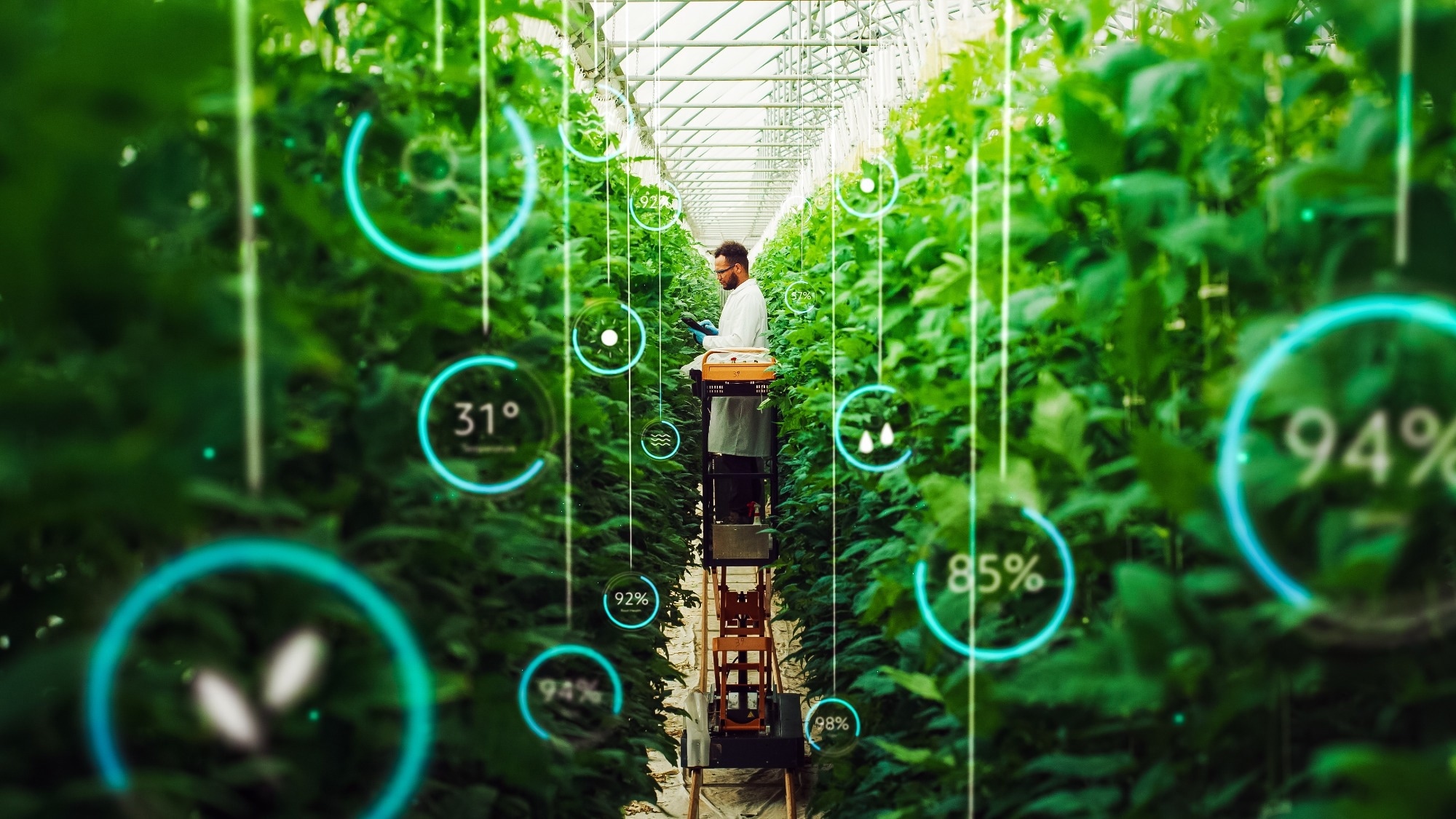Indoor farming is rapidly becoming a viable answer to major agricultural challenges. Specifically, traditional farming struggles due to decreasing farmland, changing weather patterns, and the growing global population.1,2,3 In response, Controlled-Environment Agriculture (CEA)—growing crops indoors under controlled conditions—offers a sustainable way to produce food.
However, successful indoor agriculture needs more than just infrastructure. Growers must replicate the temperature, humidity, and carbon dioxide (CO2) levels of outdoor conditions for their crop. Advanced sensor technology enables real-time monitoring and regulation of indoor environments, optimizing crop growth, resource efficiency, and reducing overall environmental impacts.
This article explores how sensors for temperature, humidity, CO2, and IoT systems are revolutionizing indoor food production.
Temperature Sensors: Precision for Peak Growth
Temperature is crucial for plant development. While outdoor crops rely on natural temperature cycles, indoor cycles must be carefully recreated.
Growers use Resistance Temperature Detectors (RTDs) and Negative Temperature Coefficient (NTC) thermistors. NTC thermistors are favored due to the following benefits:4
- High sensitivity to small changes, enabling a fast response to environmental changes.
- Lower cost ideal for operations requiring multiple sensor points.
- Compact size and versatility allow easy integration across soil, irrigation systems, or air monitoring setups.
Their responsiveness helps maintain crop-specific temperature ranges, reducing plant stress from overheating or underheating.

Image Credit: Kitreel/Shutterstock.com
Humidity Sensors: Balancing Moisture for Plant Health
Temperature and humidity are tied, influencing plant transpiration and resistance to diseases. Excessive humidity can lead to root rot and mold, whereas insufficient humidity may stunt plant growth.4,5
Common humidity sensors include:4
- Capacitive sensors, which detect changes in electrical capacitance caused by moisture.
- Resistive sensors measure changes in electrical resistance based on moisture absorption.
Capacitive sensors are preferred in indoor farming setups due to their:4
- Greater accuracy (typically ± 2 % to ± 5 % RH),
- Long-term stability and resistance to sensor drift,
- Lower maintenance needs, and
- Resistance to contamination
Such qualities make capacitive humidity sensors better suited for maintaining a consistent indoor climate, particularly in vertical farms or greenhouses.
CO2 Sensors: Controlling a Key Growth Driver
Plants need carbon dioxide for photosynthesis. While outdoor CO2 levels are relatively stable, indoor levels must be maintained between 1000 and 1500 parts per million (ppm) to maximize photosynthesis while avoiding harm.4
NDIR (non-dispersive infrared) CO2 sensors effectively measure how much infrared light CO2 absorbs. They are valued for their:4
- Accuracy in detecting CO2
- Minimal need for recalibration
- Ease of integration with automated ventilation and enrichment systems
Dual-channel NDIR sensors are well-suited for CEA environments, using a reference channel to compensate for environmental drift, maintaining accuracy even with high CO2 levels.6
IoT Sensors: Automation and Optimization at Scale
Instead of manual checks and analog meters, modern indoor farms use Internet of Things (IoT) sensor networks to monitor conditions, collecting data on:
- Temperature and humidity
- Light intensity
- Soil moisture
- CO2 levels, and more.4
Data is then fed into automated control systems that adjust lighting, irrigation, and HVAC equipment in real-time, offering advantages such as:
- Maintaining optimal growing conditions 24/7
- Reducing water and energy use by fine-tuning irrigation and lighting
- Minimizing waste and crop loss
- Freeing up human labor for tasks that require judgment or creativity
Combining sensor data can help farmers make informed decisions about crop scheduling, pest control, and resource allocation to help maximize productivity.
Customized Sensor Solutions: Tailoring Tech to the Crop
Indoor farms vary in crop types, layout, and climate systems, making one-size-fits-all sensor packages less ideal. Many growers develop customized sensor solutions, integrated with existing systems, to target specific parameters by working directly with sensor manufacturers.4
This approach enables growers to access recent innovations and supports scaling and upgrading their sensor networks as operations grow. While custom sensors may cost more upfront, the long-term savings in efficiency, yield improvement, and maintenance can outweigh the initial expenses.7
A Smarter Future for Indoor Farming
Controlled-environment agriculture offers a solution to producing food sustainably. Indoor farms replicate outdoor conditions using advanced, integrated sensor technologies.
From monitoring air temperature and humidity to managing CO2 levels and automating entire systems through IoT, smart sensors form the sensory system of indoor agriculture, enabling real-time responses and data-driven decisions.
As indoor agriculture grows and evolves, sensor technology will be critical. Investing in the right sensors and partnerships ensures better harvests, optimized resource use, and a resilient agricultural future.
References and Further Reading
- Brain, R.A., et al. (2023). The Shrinking Land Challenge. ACS agricultural science & technology, 3(2), pp.152–157. https://doi.org/10.1021/acsagscitech.2c00250.
- Varghese, S. (2023). Future of Climate Change. Future of Business and Finance, pp.69–85. https://doi.org/10.1007/978-3-031-36382-5_7.
- Ritchie, H. and Rodés-Guirao, L. (2024). Peak global population and other key findings from the 2024 UN World Population Prospects. Our World in Data. (online) Available at: https://ourworldindata.org/un-population-2024-revision.
- Amphenol Sensors (2024). IoT & HVAC System Design With Advanced Sensors. Amphenol Sensors. (online) https://doi.org/10728456187/module_40727852731_blog-post-banner.
- TIngmar Tulva, Kaspar Koolmeister and Hõrak, H. (2024). Low relative air humidity and increased stomatal density independently hamper growth in young Arabidopsis. The Plant Journal. (online) https://doi.org/10.1111/tpj.16944.
- Amphenol Sensors (2024). HVAC NDIR CO2 Sensors | Single- Vs. Dual-Channel. (online) Amphenol Sensors. Available at: https://blog.amphenol-sensors.com/industrial-blog/ndir-co2-sensor-hvac-systems (Accessed 30 May 2025).
- Amphenol Sensors. (2023). Breaking Down Custom Integrated Medical Sensor Cost. (online) Available at: https://blog.amphenol-sensors.com/medical-blog/custom-integrated-medical-sensor-cost-overview.

This information has been sourced, reviewed and adapted from materials provided by Amphenol Sensors.
For more information on this source, please visit Amphenol Sensors.